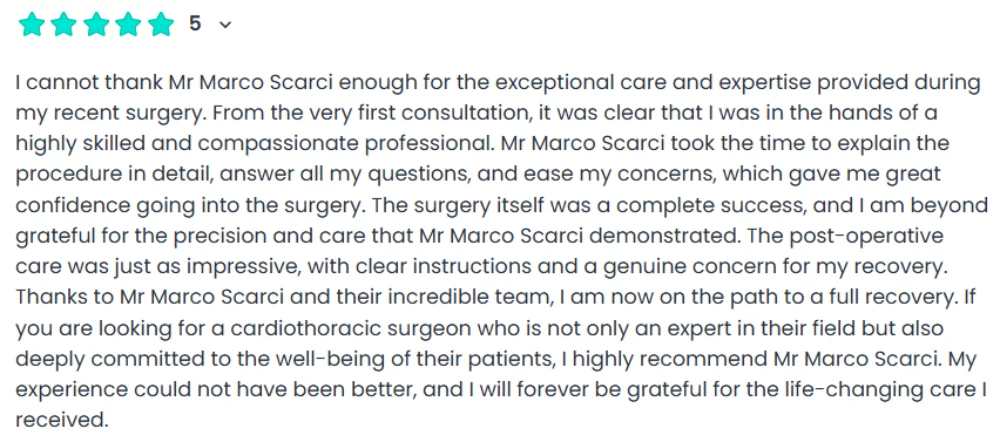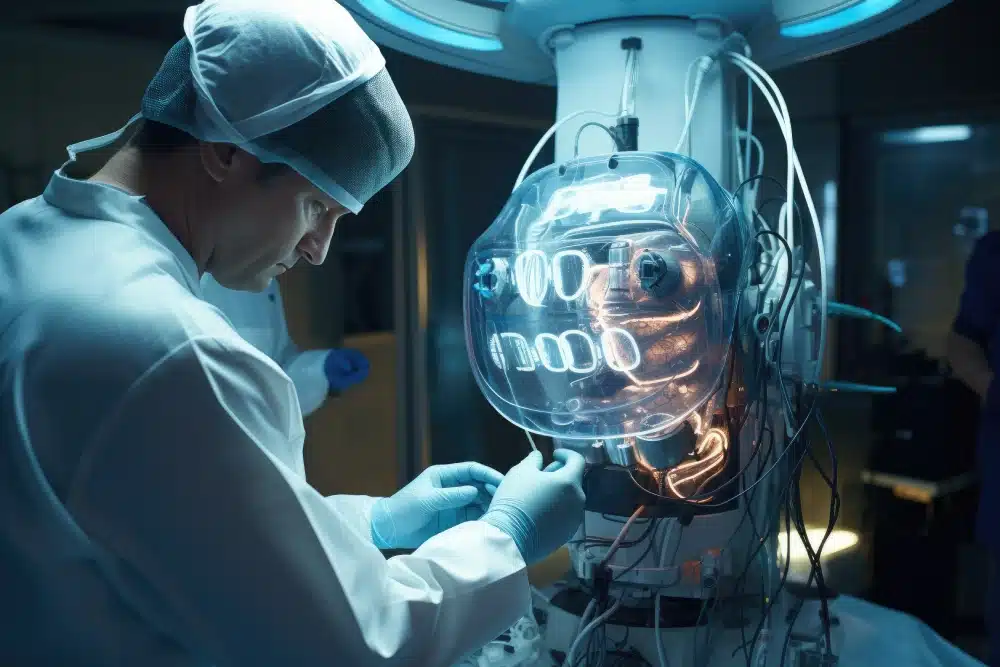Mrs Johnson sat in my office not long ago, clutching her husband’s hand.
“Twenty-three years we’ve been married,”
– she whispered. Her early-stage lung cancer diagnosis had shattered their retirement plans. Six weeks later, she rang me from their caravan in Cornwall. They’d decided not to cancel their holiday after all.
That’s the thing about robotic lung cancer surgery – it gives people back their futures. Not just survival, but proper living.
I’ve been a thoracic surgeon for decades now. When colleagues ask why I switched to robotic approaches, I show them photos. Patients hiking mountains three months post-surgery. After years performing various types of lung cancer surgery, I can confidently say this represents the future of lung cancer surgery.
What is Robotic Surgery for Lung Cancer?
Right, let’s sort this out properly. “Robotic surgery” sounds terrifying – they imagine some mechanical thing operating while doctors watch Netflix. Absolute rubbish.
I’m performing every single movement. The da Vinci surgical system just makes my hands steadier, my vision sharper. Picture this: instead of slicing through your chest, we make several tiny holes. Each smaller than a 20p coin.
The camera gives me vision better than my actual eyes. Magnified, three-dimensional, crystal clear. Works brilliantly for early-stage stuff and non-small cell lung cancer.
As a type of surgery, robotic-assisted surgery offers advantages that traditional invasive procedures simply cannot match.
Benefits of Lung Cancer Robotic Surgery
Minimally Invasive Surgical Approach
Here’s what patients notice immediately – the scars. Or rather, where they should be but aren’t. Traditional surgery leaves marks you could fit a paperback across. Robotic-assisted thoracic surgery? Four tiny dots.
Those massive old incisions meant cutting through chest muscles, spreading ribs apart. Now? We slip between ribs, work around muscles. This represents a fundamental shift in lung cancer treatment – from major surgical procedures to keyhole lung cancer surgery with robotic precision.
When considering the treatment of lung cancer, this minimally invasive surgery approach consistently delivers superior outcomes.
Precision with Robotic Technology
My hands are steady – twenty years of practice ensures that. But they’re still human hands with limitations.
Robotic instruments eliminate all that. They can rotate completely, bend at impossible angles, work in spaces where human fingers couldn’t possibly fit. When I’m dissecting around major blood vessels, that extra manoeuvrability is revolutionary.
Shorter Recovery Time for Patients
Most robotic lobectomy patients go home within two days. Compare that to traditional surgery where a week in hospital was standard.
Last month, a patient texted me a photo of himself playing football with his grandson. The surgery had been five weeks earlier. His message: “Doc, I keep forgetting I had cancer removed.” That’s becoming normal rather than exceptional.
Reduced Blood Loss and Pain
Numbers don’t lie. Robotic procedures consistently result in significantly less blood loss compared to open surgery. Most patients describe their discomfort as manageable – often surprising themselves. Less pain means better sleep, faster healing.
How Robotic Surgery for Lung Cancer is Performed
Pre-operative Preparation for Surgery
Every case starts with proper conversation. Not just medical history – I want to understand who this person is. Everyone’s concerns matter.
During Lung Cancer Robotic Surgery
The operating room looks like something from Star Trek. The da Vinci system dominates one side, all screens and robotic arms. I sit at the surgeon console, manipulating controls that translate my movements into precise actions inside the patient.
Robotic-Assisted Lobectomy Procedure
Robot-assisted lobectomy means removing the entire lung lobe containing cancer. The robotic approach shines during lymph node dissection. Complete cancer treatment with minimal collateral damage.
Robotic-Assisted Wedge Resection
Smaller tumours get wedge resection. We take out just the affected bit, preserve maximum breathing capacity.
Post-operative Care and Recovery
Recovery begins immediately. Most patients sit up within hours. The chest tube usually comes out next day. This thoracoscopic surgery approach means going home with barely-visible marks.
Who is Eligible for Robotic Surgery for Lung Cancer?
Patients with Early-Stage Lung Cancer
Early-stage disease is perfect for robotic techniques. Cancer hasn’t spread extensively, so we can achieve complete removal whilst preserving maximum healthy lung function.
Non-Small Cell Lung Cancer Suitability
Non-small cell lung cancer patients benefit enormously, especially with awkwardly-positioned tumours. Enhanced instrument manoeuvrability allows access that might otherwise require much more extensive surgery.
Importance of Lymph Node Dissection
Thorough lymph node examination remains essential for accurate staging. Robotic precision enables comprehensive node removal with minimal risk to surrounding structures.
Risks of Lung Cancer Robotic Surgery
General Surgical Risks
Every operation carries risks – bleeding, infection, anaesthetic problems. However, Society of Thoracic Surgeons data consistently shows lower complication rates with robotic approaches.
Risks Specific to Robotic Procedures
Occasionally, technical problems might force conversion to open surgery. My extensive experience minimises those concerns.
How Our Surgical Team Manages Risks
Risk management starts during our first meeting. Careful planning, meticulous monitoring, comprehensive post-operative care.
Why Choose Mr. Marco Scarci for Robotic Surgery for Lung Cancer?
Expertise in Cardiothoracic Surgery
Hundreds of robotic procedures under my belt place me amongst the most experienced thoracic surgeons in robotic thoracic surgery. Understanding how different approaches affect long-term outcomes makes the real difference.
Advanced Robotic Surgical Systems
We maintain state-of-the-art equipment, including the latest da Vinci surgical system versions. This ensures patients get treatment using the most sophisticated tools available.
Patient-Centered Care Approach
Everything revolves around individual patient needs. Clear communication, genuine compassion, personalised attention from consultation through recovery.
Proven Outcomes and Survival Rates
Results matter more than promises. My robotic patients consistently experience fewer complications, faster recovery, excellent survival rates.
Patient Success Stories with Lung Cancer Robotic Surgery
 Our patient testimonials consistently reflect these positive experiences, with many expressing surprise at how smooth their recovery proved to be.
Our patient testimonials consistently reflect these positive experiences, with many expressing surprise at how smooth their recovery proved to be.
Advances in Robotic Thoracic Surgery
Emerging Robotic Techniques
Single-port surgery represents the newest development, requiring even fewer incisions. Enhanced imaging and improved instruments keep expanding minimally invasive possibilities.
Research in General Thoracic Surgery
Studies from institutions across Europe and the United States consistently validate robotic approaches. This research drives continuous improvement in techniques and patient outcomes.
How Our Services Can Help You
Personalised Plans for Lung Disease
Every patient brings unique circumstances. Treatment recommendations consider medical factors alongside lifestyle needs and personal preferences.
Comprehensive Care from Diagnosis to Recovery
Care coordination covers the entire journey. We work closely with oncologists and specialists, ensuring seamless treatment from diagnosis through recovery.
Access to Mr. Scarci’s Expert Surgical Team
Our entire team specialises in robotic procedures. Collective expertise ensures every aspect of care meets the highest standards.
Frequently Asked Questions
What is the recovery time for robotic lung surgery?
Most patients return to normal activities within 2-4 weeks, dramatically faster than traditional surgery requiring 6-8 weeks.
Is robotic surgery covered by insurance?
Most private policies cover medically necessary robotic lung cancer surgery. Our team helps with insurance matters during consultation.
How does robotic surgery for lung cancer compare to other procedures?
Compared to open surgery: superior precision, smaller incisions, less pain, reduced blood loss, faster recovery. Compared to video-assisted thoracic surgery (VATS): enhanced visualisation and better instrument control.
Cancer diagnosis brings enough worry without adding surgical recovery concerns. Schedule a consultation to explore whether robotic surgery suits your situation.






